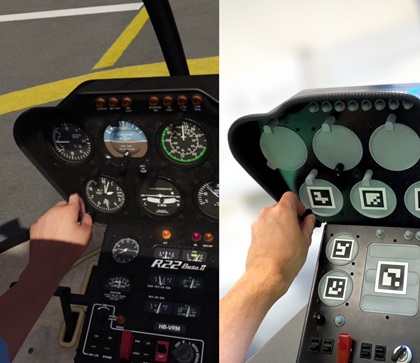Virtual reality training device for R22 certified
EASA approval touted as world's first
VRM Switzerland thinks it has cracked the code. Many training and simulation companies have promoted the benefits of virtual reality training, but until recently most of the applications had too many drawbacks to be considered effective. Working with the European aviation authorities, VRM Switzerland said recently it has become the first company in the world to receive certification for a virtual reality simulation device that can be used in lieu of time in the aircraft to meet training minimums.
Instructors sit outside the motion platform in a three-screen setup that shows the aircraft environment, and critically, where the pilot is looking. VRM Switzerland CEO Fabi Riesen calls this a “value add” that gives the instructor a greater ability to monitor the student’s progress.
 The company has also incorporated an advanced control feedback system. In a traditional training environment, helicopter students start with a small margin for error, and especially in Robinsons, the instructor’s hands are often still on the controls, even when the student is supposed to be flying. It can be difficult for the student to know when he or she is controlling the aircraft. In the VRM device, the computer has limits that give the student more control, without making it so difficult for new pilots as to not be effective training. As the student gains proficiency, the system can be tuned down to better approximate the helicopter.
The company has also incorporated an advanced control feedback system. In a traditional training environment, helicopter students start with a small margin for error, and especially in Robinsons, the instructor’s hands are often still on the controls, even when the student is supposed to be flying. It can be difficult for the student to know when he or she is controlling the aircraft. In the VRM device, the computer has limits that give the student more control, without making it so difficult for new pilots as to not be effective training. As the student gains proficiency, the system can be tuned down to better approximate the helicopter.
Although the initial simulator is for a Robinson R22, the company has plans for more, including the popular Airbus H125. With the full visual field, it’s even possible to train external sling loads realistically in the simulator.
European Union Aviation Safety Agency certification enables users to log five hours toward a private pilot certificate, and up to 20 hours for a commercial pilot certificate. Riesen said “there are a lot of things already going on” regarding future plans with FAA approvals.
Pricing on the simulator varies, but Riesen said in all cases training time in the VRM will be less than in the aircraft. The company set that as a requirement early on, knowing that any safety enhancing device must be a good value.




